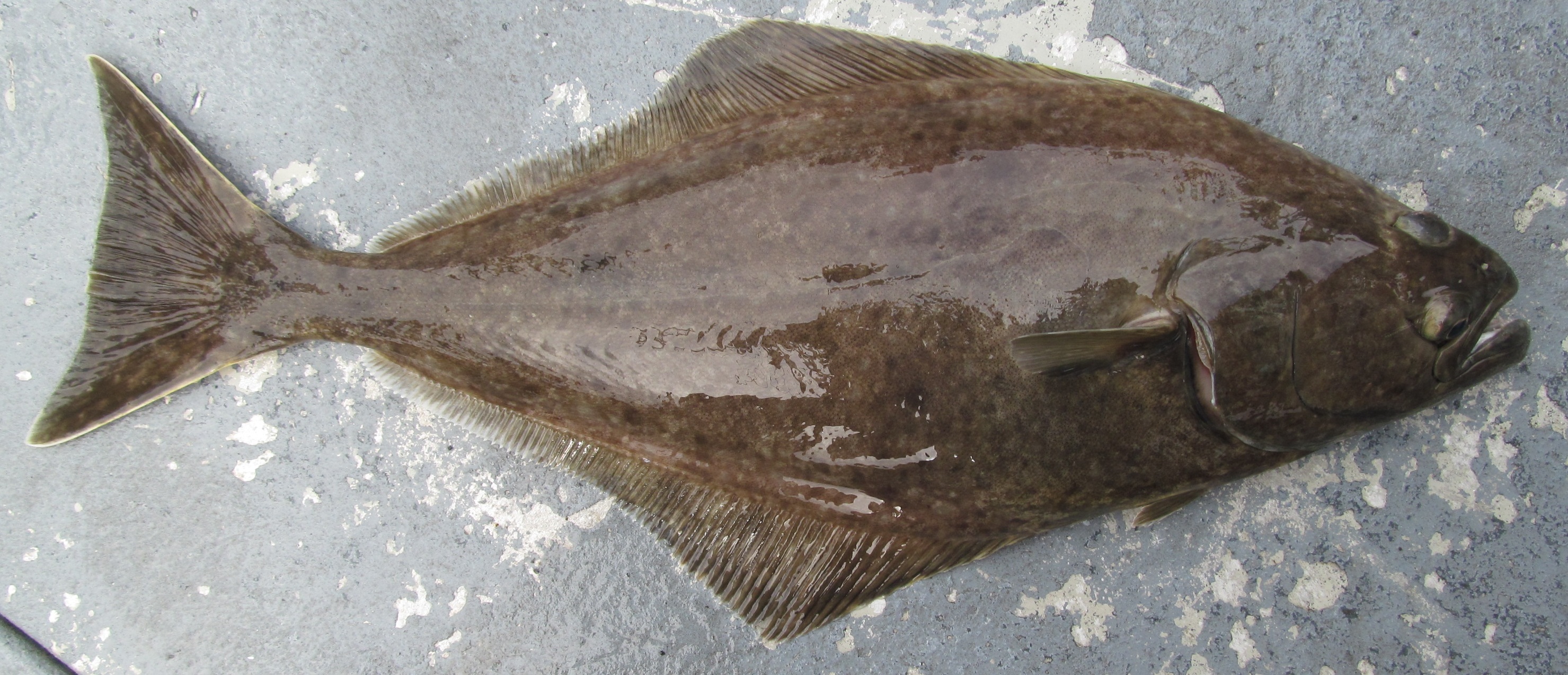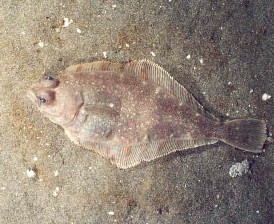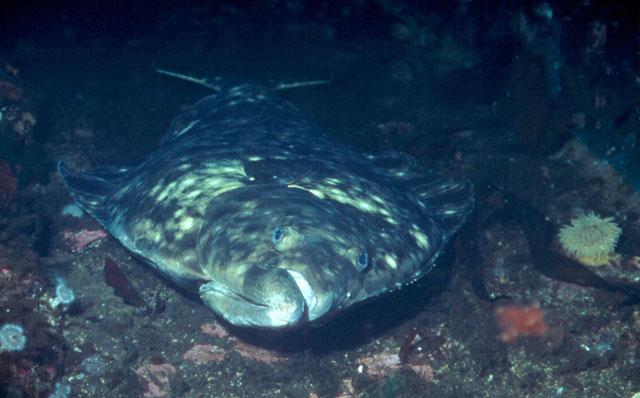
Hippoglossus stenolepis
FAMILY
Pleuronectidae
TAXONOMY
Hippoglossus stenolepis Schmidt, 1904, Aniva Bay, south Sakhalin
Island, Sea of Okhotsk.
OTHER COMMON NAMES
English: Northern halibut, right halibut; French: Flйtan du
Pacifique; Spanish: Fletбn del Pacifico.
PHYSICAL CHARACTERISTICS
One of the largest species of flatfishes and among the largest of
bony fishes. Typically dextral flatfishes, with a thick, sturdy,
elongate, and diamond-shaped body and a highly compressed
caudal peduncle with a crescent-shaped caudal fin that often is
indented near the edges. The head is large, with a large terminal
mouth featuring a wide gape. Nearly symmetrical jaws containing
two rows of prominent, conical teeth on the upper jaw
and a single row of conical teeth on the lower jaw. The eyes
are large, and the upper eye is slightly in advance of the lower
one. The lateral line has a high arch above the pectoral fin.
Small cycloid scales cover both sides of the body. Ocular side
coloration is greenish brown to dark brown or black, marbled
with lighter blotches; the blind side usually is white to milky
white, sometimes also with blotches. Females reach lengths up
to 8 ft, 9 in (267 cm), and weights of about 498 lb (226 kg);
males are about 4 ft, 7 in (140 cm) and 220 lb (100 kg). Females
grow considerably faster and typically live longer than do males.
Almost all halibut larger than 100 lb (45.5 kg) are females. Halibut
first become available to the offshore fishery at about five
to seven years of age. The oldest recorded age for a male is 55
years, and the oldest recorded age for a female is 42 years.
DISTRIBUTION
Marine waters of the eastern and western North Pacific Ocean.
In the west, they are found from the Sea of Japan and Okhotsk
Sea north to the Gulf of Anadyr and Chukchi Sea and
throughout the Bering Sea. In the eastern Pacific, this species
ranges from the Gulf of Alaska southward to about Santa Barbara,
California, and, rarely, southward to Point Chamalu,
northern Baja California.
HABITAT
Occurs on a variety of bottom types at depths from about 19.7
to 3,609 ft (6–1,100 m) but most commonly found between 180
and 1,385 ft (55–422 m). In summer they are found between 92
and 902 ft (28–275 m) and sometimes shallower, whereas most
halibut occur in deeper waters during winter. They have a preferred
temperature range of 37.4–46.4°F (3–8°C).
BEHAVIOR
Diurnally active fishes found most often on the bottom. They often
rise off the bottom into the water column and may at times
even come close to the surface when pursuing prey. Seasonal
movements of adults are associated with winter reproduction offshore
and summer feeding inshore. Adult halibut move seasonally
from deep water to the edge of the continental shelf and then to
shallower banks and coastal waters during the summer; they
move back to deep water in the winter. Migrations may be extensive—
the longest migration on record was that of a fish tagged
near Atka Island in the Aleutian Islands, which was recaptured at
Coos Bay, Oregon, a distance of 2,500 mi (4023 km).
FEEDING ECOLOGY AND DIET
Large, powerful, opportunistic, visual feeder that consumes a
wide variety of prey, including fishes, crabs, clams, squids, and
other invertebrates. Small halibut eat a variety of benthic prey
items and small fishes, with prey size increasing with fish
length. Larger halibut consume almost anything they can
catch, with fishes constituting a major portion of their diet.
They also feed on squid, octopus, and diverse benthic and nektonic
fishes, including cods, pollock, rockfishes, sculpins, other
flatfishes, and occasionally smaller halibuts. Halibut are eaten
by marine mammals, perhaps some sharks, and other halibuts,
but because of their large size, they are rarely found as prey for
other fish species.
REPRODUCTIVE BIOLOGY
This species spawns in deep water, 902–1,352 ft (275–412 m),
at the edge of the continental shelf during winter (November to
March). The Gulf of Alaska is an important spawning area. On
average, females mature at 12 years of age (range, eight to 16
years), and males mature by about age eight. The number of
eggs produced increases with the size of the female. Large females
(those more than 250 lb, or 113.4 kg) can produce as
many as two million to four million eggs annually. The eggs
are buoyant and fertilized externally. Larvae hatch in about 15
days, depending on water temperature; they remain pelagic for
four to five months after spawning. Eggs may be encountered
anywhere between 131 and 3,068 ft (40–935 m) but are concentrated
between 328 and 656 ft (100–200 m). Newly hatched larvae
(0.3–0.6 in, or 8–15 mm) usually are found deeper than 656
ft (200 m). Eye migration begins at a length of about 0.7 in (18
mm). By 1.2 in (30 mm) the young fish resemble adults. With
growth, young fish rise in the water and are found predominately
at about 328 ft (100 m) by three to five months of age.
They are transported great distances and move shoreward with
currents, where they settle to the bottom at about six to seven
months. After about two years, juveniles begin to move into
deeper water. Fishes ages two to four years occur primarily at
361 ft (110 m) or shallower, but some at this size also have
been taken at depths of 597 ft (182 m) and occasionally deeper.
CONSERVATION STATUS
Not threatened. Exploitation has resulted in stock reductions
of this species throughout its range. Commercial and recreational
halibut fisheries are highly regulated, with size and seasonal
limitations employed to attempt to keep stocks from
diminishing further or disappearing altogether.
SIGNIFICANCE TO HUMANS
Largest and most commercially important flatfish in the North
Pacific Ocean. Excellent table fare highly prized by consumers.
A commercial fishery for halibut has existed for longer than
100 years.
Other popular Animals
Photo Gallery of - Pacific halibut





 Animalia Life
Animalia Life